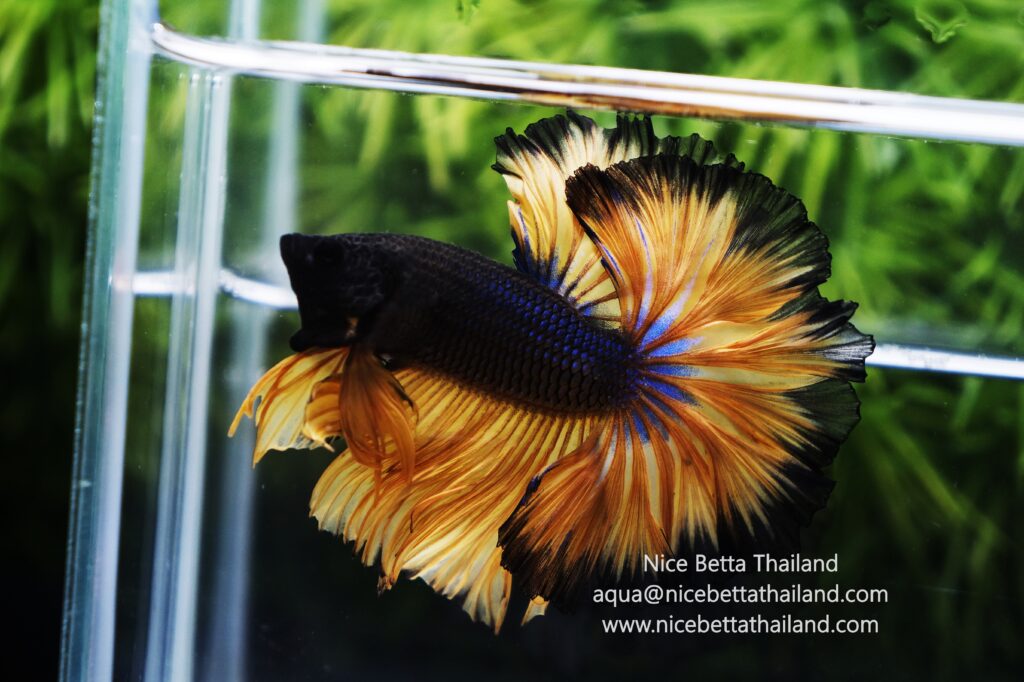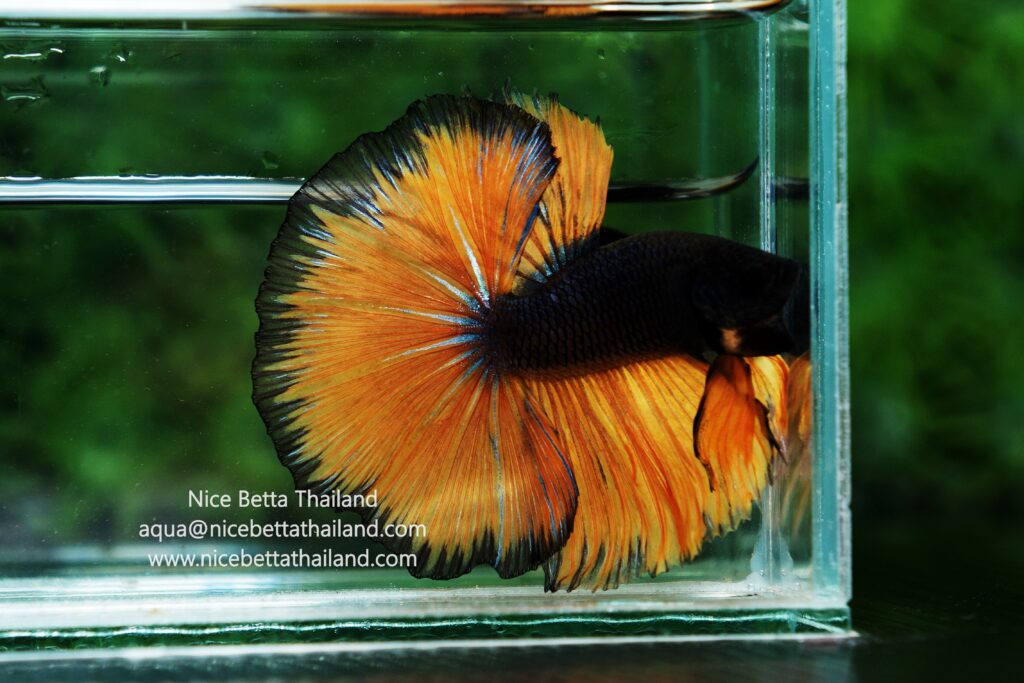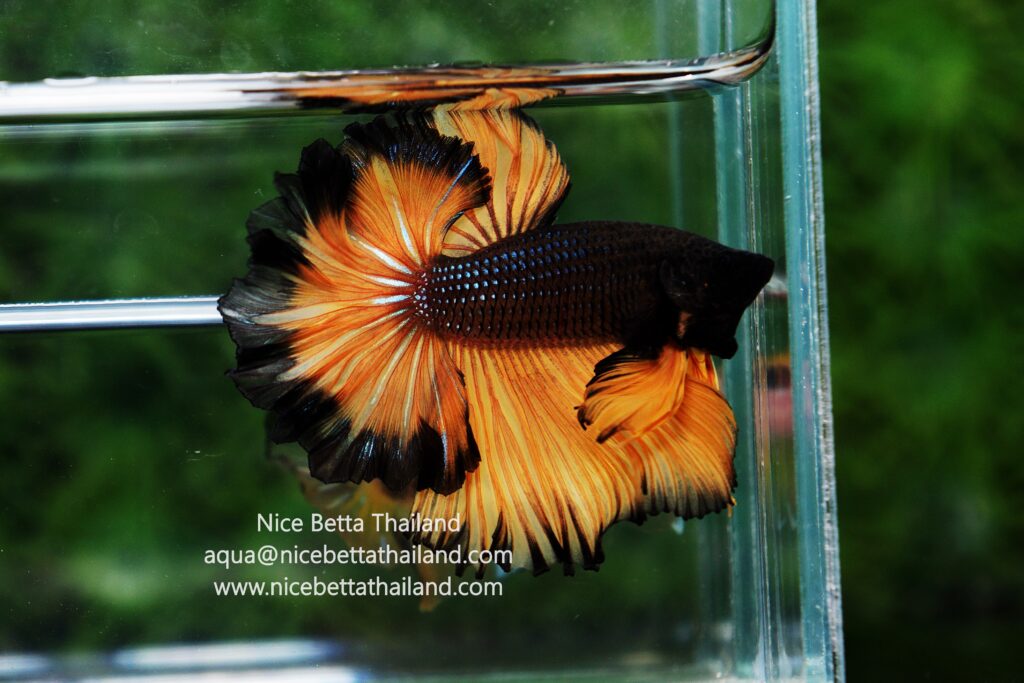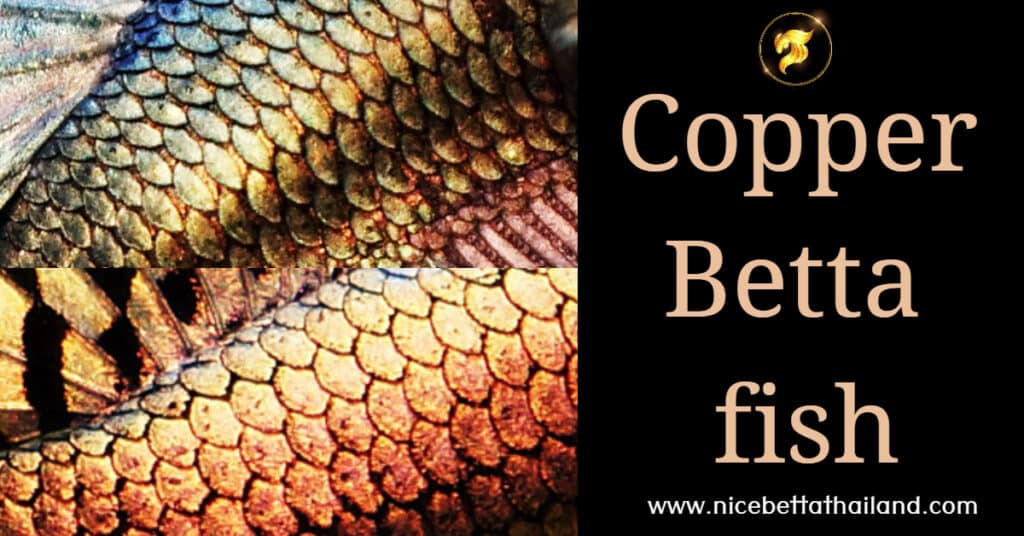If talk about Chocolate bettas. There seems to be a lot of confusion surrounding the so-called ‘chocolate’ betta popular among hobbyists today. What exactly is it? How is it made up genetically? What is the difference between the chocolate betta and the ‘Mustard Gas’ or ‘pineapple’ betta fish
The chocolate betta?

What you must first recognize is that the IBC does not officially recognize a the Betta fish color ‘chocolate’. The brown body/yellow fin combination that is commonly referred to as chocolate these days would be classifed as a dark bodied bicolor for IBC showing purposes. The term ‘chocolate’ is actually a strain name given to describe a particular color variation; by whom or for what color is still a matter of contention. In his very good book Bettas: A Complete Introduction, the late Walt Maurus first described the chocolate betta as a plain solid brown fish with or without black edges or the freckling of melanophores in the finnage. According to Maurus, these chocolate bettas behaved genetically very similarly to the melano, leading one to speculate if the original chocolate color was an offshoot of the mutant melano gene. At the time of the writing of his book Maurus states the chocolate brown betta was not considered an attractive fish by most hobbyists, and was not being pursued with any real seriousness.

What is a Chocolate Betta?
In recent times, the term Chocolate betta fish has come to be applied to a brown bodied betta with yellow fins. It is interesting to note that this color combination was also described by Maurus in his book, but he referred to it as ‘brown/yellow bicolor’ — not chocolate! The color combination has been in existence for many years, but has only recently gained notoriety when some enterprising breeder began selling it under the ‘chocolate’ strain name.
Genetically similar to the ‘Pineapple’ betta, the chocolate is considered a non-red. However, where the Pineapple is a phenotype produced by the NR-1 mutation on the black scaled extended red betta, chocolate seems to work as a true bicolor like the common *’Mustard Gas’ betta. Where the MG has a green or blue body, the chocolate betta seems to be the NR gene working on black, producing a yellow/black (brown) phenotype.

Breeding Chocolates
Genetically, modern Chocolates betta fish are homozygous for the recessive non-red (yellow) gene and carry at least one normal dark gene. Spawning a chocolate to a chocolate can produce 100% chocolates, or some pure yellows. Crossing chocolate to a solid, non-metallic iridescent, unseen recessive traits aside, will produce multi-colors in the first generation, because the first generation should be able to show normal red along with the iridescence that the parents carry genetically, but do not show phenotypically.
I’ve often been asked what would happen if you were to breed a chocolate to a melano. I believe the question is a logical one, based on the assumption that the dark bodied, non-iridescent chocolate would reduce the iridescent fault on the melano while still maintaining a very dark fish. In a series of experimental spawns, I tried this particular crossing. The results were intriguing.
Because melanos are homozygous for the recessive melano gene, the first generation did not produce any melanos, which is to be expected unless the chocolate carries melano. Similarly there were no NR-1 yellows since the melano father did not carry the recessive NR gene. The results were 100% multicolor. Using two well-finned individuals from the first spawning, we produced more multicolors, along with some melanos, chocolates, and melanos homozygous for the NR-1 gene. Since the melano is now believed to be related to production of red (or rather a variant of it), the mutant gene caused a reduction of the melano effect by blocking its development, producing blacks which were washed out in appearance.

Since most of the melanos weren’t homozygous for NR-1, not all of the individuals in the spawn were affected. The darkest males from this spawn showed a lot of red under the light, leading me to believe they did not carry the NR-1 recessive. This necessitated a decision: Use the darkest male which was probably not a carrier for non red, or choose one of the paler melano males from the same spawn, and try to improve the color through selective breeding after having isolated the NR-1 gene? I chose the former, mainly because spawning the darkest melano with the lowest iridescence seemed like the logical choice, and I hoped successive sibling crosses would increase the number of melanos carrying the NR-1 gene.
Most chocolates and yellows carry genes for the dominant extended red. The yellow color you see in the two types is actually red suppressed by the NR-1 gene. If you’re using a chocolate to introduce the yellow gene, then extended red is part of the package; the chocolate you’re using will likely also carry the gene for extended red. If they didn’t, the fins would be absolutely clear in appearance instead of yellow.
Crossing a chocolate to a yellow will produce 50% chocolate and 50% yellow as long as the chocolate carries the gene for Cambodian (sometimes referred to as ‘non black’). If the chocolate does not carry the Cambo gene, you will likely get all chocolates, all of which will be cambo genotypes and therefore able to produce some yellows when crossed to another chocolate carrying the Cambo gene or a yellow. If the chocolate does carry Cambodian, you will get the 50/50 chocolate and yellow split with all of the offspring being homozygous for Cambodian.

What Does An Ideal Chocolate Betta Look Like?
I’ve always firmly believed that every betta color variation should be celebrated for what it is, and not forced to conform to the standards which define any other color/pattern. In that vein, I always look for chocolate bettas which have a light brown or dark brown body and solid yellow fins. The body should be free from iridescence, and the fins devoid of any butterfly or variegated pattern. If a betta is so dark that it appears black in the body, it is not a good chocolate. Similarly, a betta which carries excessive iridescence such as blue or green would probably be more appropriately classified as a blue/yellow or green/yellow bicolor, or (when warranted) a multicolor.
Also we have group talk about betta fish for sale and share any new tip take care information on Web3 socialFi group

Right now we have betta fish doctor help every bettas lover by top breeder in Thailand to cure or share more tip on Animalverse social
If your bettas fish sick or need tip to treat help or join event prize with AVC Token
Let’s join the group many top breeder will help to answers in betta fish community
More tip :
All of Betta Fish A Guide on Patterns, Color in the world
The most expensive betta fish in the world.
15 Common Betta Fish Diseases Prevention and Treatment






